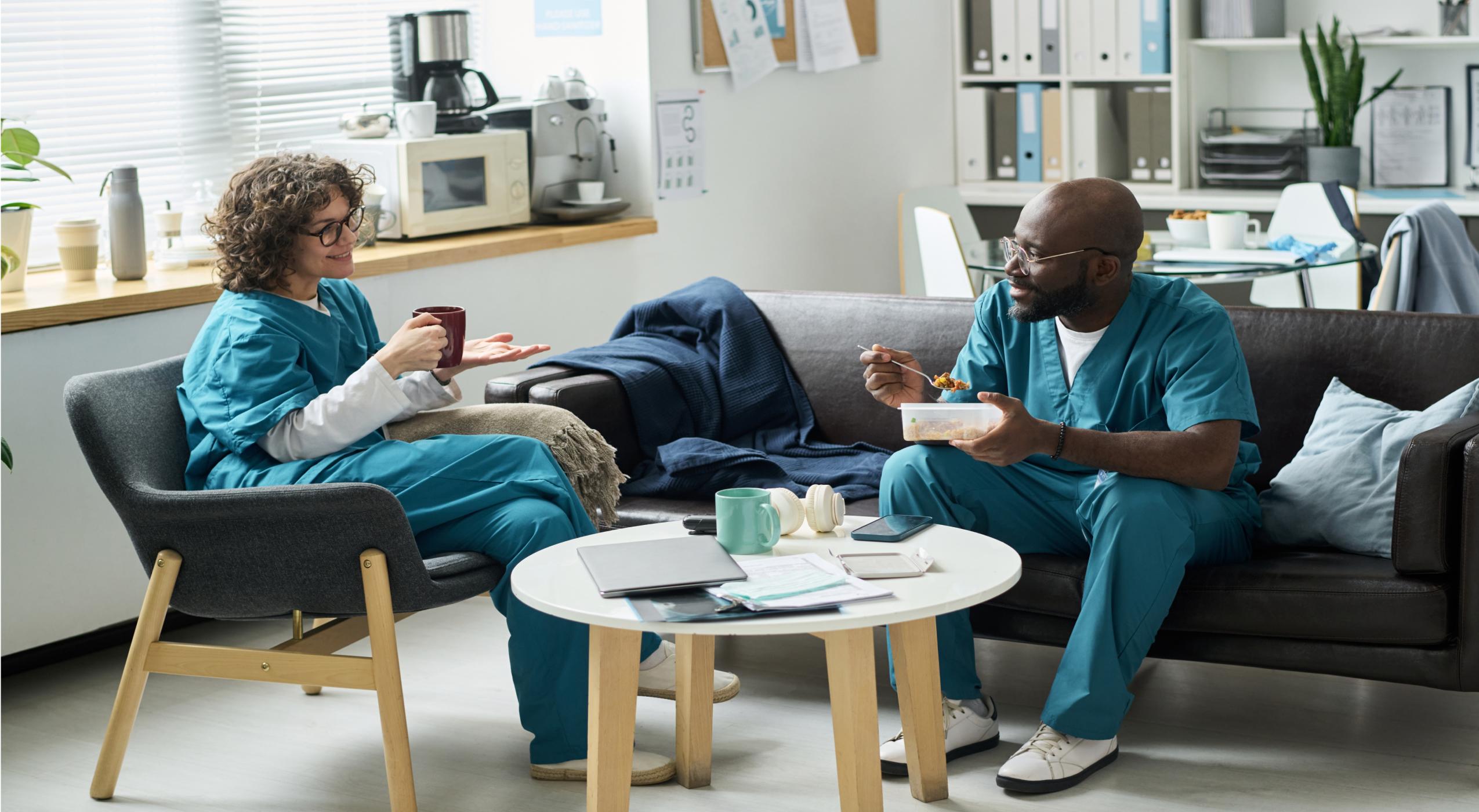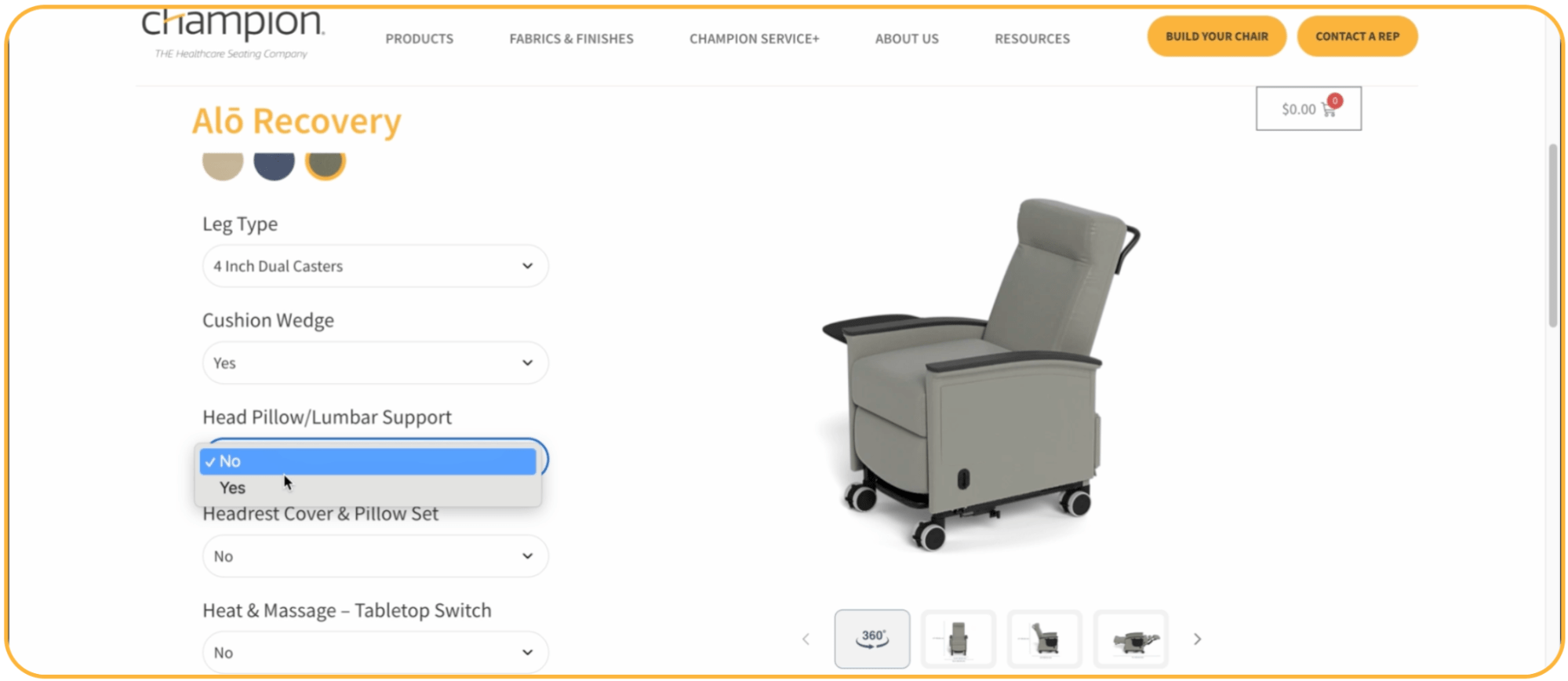
Every day, nurses and clinical staff push through long shifts filled with nonstop demands—med passes, charting, emotional support, and emergencies. But despite their essential role, many aren’t getting even the most basic opportunity to rest and recharge. According to Critical Care Nurse, one in three nurses rarely take breaks during a shift, a pattern shown to negatively impact both performance and overall well-being. For the largest segment of your workforce, that’s a serious red flag.
The reasons behind skipped breaks are complex—short staffing, patient acuity, and organizational culture all play a role. But the consequences are clear: lower morale, higher turnover, and increased risk of burnout. For leaders in nursing, outpatient services, and perioperative care, that’s a direct threat to quality, safety, and performance.
The good news? One of the most overlooked but effective ways to boost nurse morale and retention starts with an environment upgrade: the staff break room.
In this blog, we’ll explore five research-backed strategies from Staples Business Advantage to improve your healthcare break room—and how an ergonomic, well-equipped space can help your nurses feel more human again.
1. Make Employee Breaks the Norm, Not the Exception
Culture starts at the top. When nurses feel pressure to skip breaks, it’s often tied to a workplace culture that equates rest with weakness—or worse, guilt. The first step toward real change is normalizing the idea that breaks are not optional; they are essential.
Sign up to get the latest industry news and offers right in your inbox
Nurse managers and clinical directors can lead by example, openly taking breaks and encouraging their teams to do the same. Break schedules should be built into staffing plans, not tacked on when time allows. Make it clear: Stepping away isn’t slacking off. It’s a safety measure, a recovery tactic, and a basic human right.
Consider reinforcing this message visually. Simple signage—like “Your Break Matters” or “Rested Nurses Provide Safer Care”—can serve as everyday reminders that rest isn’t optional; it’s essential to safe, effective care.

2. Rethink the Staff Break Room Layout for Functionality and Flow
The design of a break room can influence whether staff actually use it, and whether it offers any real relief. A well-laid-out space should feel intuitive, accessible, and inviting, not just a catch-all corner for leftovers and paperwork.
Start by identifying common friction points: Is the fridge hard to access during busy times? Do people tend to crowd around the microwave or coffee maker? Are there places to sit without feeling like you’re in someone’s way?
Optimizing the layout doesn’t require a full remodel—it’s about making better use of what’s already there. That could mean rearranging tables to reduce crowding, choosing more compact or flexible furniture, or decluttering high-traffic zones so they’re easier to navigate. It also helps to consider lighting, acoustics, and the overall tone of the space: Is it somewhere you’d want to step into during a stressful shift?
A functional, well-maintained break room communicates that staff well-being is part of the culture, not an afterthought. And that message goes a long way in boosting morale.
3. Create Employee Break Zones for Real Recovery
Not all downtime is created equal. Eating lunch while fielding patient calls or catching up on charting isn’t a true break—it’s task-shuffling. For a break to be meaningful, staff need a space that signals separation from work.
That’s why it’s important to create different zones within the break room: one for eating and conversation, and another for quiet rest or recovery. Even a small recliner nook with dimmer lighting or noise-reducing panels can help a nurse reset between tasks.
And it’s not just a luxury—nearly 73% of nurses say a high-quality break room helps reduce stress and fatigue.
If you’re limited on space, even modest adjustments—like a sound machine, plants, or soft lighting—can help a corner of the room feel like an actual retreat.
Bonus: These zones can also double as decompression areas after high-stress events.
Read More: “Healthcare Design Trends: Creating Healing Environments For Patients and Staff”

4. Add Thoughtful Amenities That Support Well-being to the Employee Break Room
The best break rooms aren’t just places to eat—they’re places to recover. That includes mental, physical, and emotional restoration.
Make it easy for nurses to nourish themselves by keeping essential amenities well-stocked and functional. Ensure the fridge is clean and filled with water and healthy snacks, and that the microwave and other appliances are reliable and easy to access. Small wellness upgrades can also enhance the space, such as:
- A charging station for phones and devices
- Diffusers or aromatherapy tools (if appropriate for your facility)
- White noise machines or calming music options
- Hygienic noise-cancelling headsets for staff who prefer silence
- Ergonomic recliners where staff can put their feet up, stretch, or just breathe
And don’t underestimate the value of aesthetic updates. A fresh coat of paint, a touch of natural light, or motivational art can dramatically shift the energy of the space.
5. Listen to the People Who Use the Space Most
Finally, your staff already knows what they need. Ask them.
Anonymous surveys, suggestion boxes, or informal feedback can give you insights into what matters most—whether it’s better lighting, improved seating, or just a more consistent break policy. When you implement these ideas, share credit with your staff and keep the conversation going. It’s one more way to show that leadership values their experience and input.
Consider forming a small “wellness working group” made up of staff nurses, educators, and patient safety leaders to help inform break room design and usage policies. Involving them in decision-making increases both engagement and impact.

Why Healthcare Break Rooms Matter More Than Ever
With staffing challenges and burnout on the rise, healthcare organizations can’t afford to ignore the break room anymore. A better break room isn’t a luxury—it’s a strategy.
Improved break spaces help:
- Reduce fatigue-related errors
- Support patient safety and fall prevention efforts
- Increase nurse retention and morale
- Signal respect for caregivers as people, not just professionals
And with the Health Resources and Services Administration projecting a shortage of over 78,000 registered nurses in 2025, retention strategies that prioritize staff well-being have never been more critical.
Quality care starts with a well-supported care team—and that support isn’t just about staffing levels or protocols. It’s about creating environments that prioritize physical comfort, mental recovery, and human connection. When caregivers have a place to rest, reset, and feel valued, the results show up in every interaction with patients, with colleagues, and within your culture.
Thoughtfully Designed Medical Seating for Demanding Healthcare Environments
At Champion Healthcare Solutions, we design ergonomic seating that supports healing, enhances clinical workflow, and stands up to the demands of daily patient care—because comfort, durability, and performance should never be compromised.

Curious how our chairs can fit your space and support your workflow? Use Champion’s new virtual chair configurator to build and preview your selection online. Then, request a quote for your facility.
